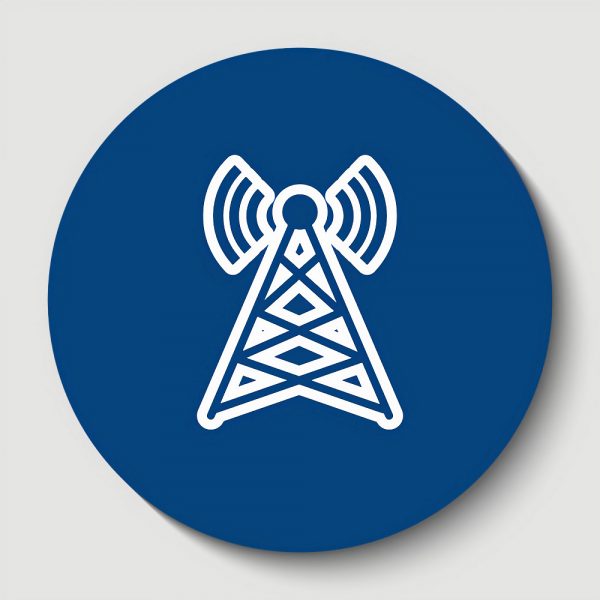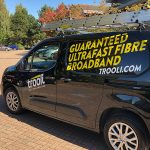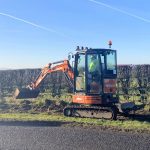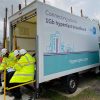Virgin Media to Supply Fibre Capacity for Three UK’s 5G Network

The business division of broadband ISP Virgin Media (Liberty Global) has this morning confirmed that they’ve signed a new deal with mobile network operator Three UK, which will see VMB’s fibre optic lines being harnessed to supply capacity (backhaul) to fuel over 3,000 of the mobile firm’s new ultrafast 5G sites.
At present Three UK already has a number of fibre optic capacity deals to help fuel their network, such as with SSE Enterprise Telecoms (SSEET), BT (Openreach) and – mostly recently – Cityfibre (here). All of this is helping to fuel their deployment of gigabit-capable 5G mobile (mobile broadband) technology, which only started properly in February 2020 (here).
Suffice to say that it makes perfect sense for Three UK to sign a capacity deal with Virgin Media too. The national cable giant has already got a similar arrangement in place with Vodafone, although today’s announcement has taken on a new significance in light of the fact that both the parents of O2 and Virgin Media have confirmed they’re discussing the possibility of a UK merger (here).
Advertisement
Three UK’s deal with Virgin Media Business seems to be focused on 5G sites, although Cityfibre informed us that they remain Three’s “preferred backhaul provider for its nationwide 5G rollout outside London“. Sadly an official press release has not yet been issued, although both sides have confirmed the agreement and we’ve got a comment from VMB.
Peter Kelly, MD of Virgin Media Business, told ISPreview.co.uk:
“We’re building the high capacity fibre backbone that will link mobile phone masts and cell sites across the country and power the UK’s 5G future.
With a powerful network and skilled engineers already in place, our infrastructure will help mobile operators to roll out their 5G network at scale. Virgin Media Business is fast becoming the backhaul bastion for 5G rollout.”
Similarly Three UK’s COO, Susan Buttsworth, said the deal would “help to meet the growing demand” for data. Just to be clear, under this deal VMB will provide dark fibre backhaul services to many of Three UK’s existing and future 5G cell sites across the country. The agreement will also see them build “full fibre” connections to urban hotspot locations as part of Three’s programme to “densify its 5G network and enhance its 4G service.”
Meanwhile any future merger between Virgin Media and O2 in the UK seems unlikely to have much of an initial impact on existing MVNO and backhaul fibre arrangements with third-parties (except for the merged parties of course – where big cost savings and convergence are expected), as to do so might raise regulatory concerns given the position of both operators in the market as key suppliers.
UPDATE 6th May 2020
Advertisement
Cityfibre has been in contact to confirm that they remain Three’s preferred backhaul provider for the nationwide 5G rollout outside London.
Mark is a professional technology writer, IT consultant and computer engineer from Dorset (England), he also founded ISPreview in 1999 and enjoys analysing the latest telecoms and broadband developments. Find me on X (Twitter), Mastodon, Facebook, BlueSky, Threads.net and Linkedin.
« Scottish Wireless Build 1Gbps FTTP Broadband to Loch Lomond























































aha so not only will it be slow like three usually is .. but it’ll go offline every 16 minutes for a day because of magic network critters that randomly pop in and out of our universe to take random ethernet frames into another network dimension.
This is great news. I’m excited to see how 5G develops, not only with my provider Three, but with the other Operators too.
It’s good to see these companies opening up deals & putting their dark fibre to use.
5G is dangerous and should be outlawed. 10,000’s birds have mysteriously fallen from the sky, due to their gamma radio waves!
The key question here is if Three is planning to build new masts or just add 5G antennas to existing ones?
If latter, then nothing will really change.
due to the way 5G works they will use some of the current masts but will have to put way more in place to provide the infrastructure that 5G needs. I would not be surprised if the networks share each others equipment as the plan is to have 5G repeaters on loads of lamp posts / buildings etc to help support the bandwidth.
@Peter
I wonder if the idea is to have a fibre backhaul + local area mesh to counter low propagation of 5G signal.
Something similar is done (Fibre to cabinet + WIFI mesh on lamp posts) in the highways/road traffic industry though the throughput there is very low.
The 5g microcells thing will only exist for 25-35ghz 5g,
cost to much to place microcells all over the place apart form high demand areas like transport hubs and large events or places with lots of people in small area,
5g coverage be via low band 600-900mhz Later date and midband 1.8-2.6ghz later date and right now it’s 3.5ghz currently
It is a bit worrying how all the networks are reliant on another in some way.
Take VM’s recent issues that also affected Sky and many ISP’s that rely on VM business leased lines!
Sadly that is fairly normal, not just in the UK but other markets too. But as the above deal shows, there are usually more than a few suppliers involved as most companies will diversify their supply chain.
In the absence of a clear Telecommunication framework that provides visibility to cellular and fixed line providers – to plan, deploy and commission and sets resiliency within a sector we are left with where we are –
A de-nationalised behemoth and some loose change of operators who were in no hurry to bring fibre to the P.
Everyone relies on everyone else at some point because the work needed to put fibre in the ground is expensive, and it doesn’t make economic sense to dig everywhere up so you don’t rely on a competitor ever.
All things being equal, most would prefer to use their own infrastructure because they don’t have to pay constantly to lease fibre from someone else, unless they don’t want to deal with the hassle of repairing fibre and transmission equipment. But there is a large cost to putting in and keeping it running.
Also consider that if everyone had to use their own infrastructure this would leave only a handful of players in the market.
If only, we started of laying fibre years ago and had some form of overbuild.
An interesting note is how VM will provide fibre to Three’s masts/sites while properties a stone throws away would have to endure HFC until 20somethings.
Aside from VMs seeming inability to manage contention and congestion on their network – no one is really ‘suffering’ from HFC as it offers massive speeds currently and the potential to offer much higher. VM does a good job on increasing their max speed offering.
Plus – anyone on their ‘full fibre’ option still gets converted to coax at the house and gets the same speeds/service from VM anyway..
An interesting note would be how much more valid your opinions would be if you had a clue what you were writing about, Dean.
@Carl
Have you understood the context of what I have written or being an internet troll comes natural to you?
You comment on here regularly enough so I will assume you are aware that:
1.VM are bringing Docsis 3.1 to their current HFC served areas
2.VM have no plans to upgrade residential HFC to fibre
3.This article is about VM providing 5g to 3’s masts
4.Lets say you live on a street where 1 and 3 above are true you end up having fibre metres away from you serving three but you are stuck on HFC
5.Money talks – 3 is paying for fibre, VM dont need to provide or upgrade beyond docsis 3.1 to meet the governments 2025 Gigabit capable broadband hence have no incentive to move their behinds, unless a competitors shows up in that particualr area
You want more?
@Dean
VM is upgrading its complete network to DOCSIS 3.1 by the end of 2021, so yes it includes FTTP. Furthermore VM markets exactly the same broadband packages on both HFC and FTTP, so it’s hardly a drawback that anyone will be “stuck on HFC”.
Dean,
1) Yes. This has what to do with this article?
2) Is not entirely accurate, it’s being looked at. After 85/1.2 HFC the costs get higher quickly and FTTP overbuild can become realistic, especially if upstream capacity is a major driver.
3) Is wrong. They are providing fibre to masts, 5G is on the radio side.
4) So what?
5) Indeed it does. Again, so what?
Company pays VM to provide fibre to infrastructure and your complaint seems to be that VM aren’t overbuilding HFC with FTTP. Not sure what delivering fibre to 3,000 sites has to do with delivering it to about 14 million.
This isn’t as you put it ‘interesting’ it’s blatantly obvious. Indeed you have yourself said that money talks and there’s no commercial case.
A large section of the UK would love to be stuck with HFC and given it can go to symmetrical 10 Gbit I don’t really get the obsession with FTTP. Surely it’s about the service delivered not how it is delivered?
With that I’ll leave you to carry on with the complaining.
@Tom Without going into the apparent superiority of Light vs Copper for data transmission let alone lesser electrical interference, HFC is at best a stop gap given the other option is repackaged FTTurdC.
Why bother with technology when smoke messages can do the trick for sending a message? 🙂
HFC is not something that should be touted as an end game regardless of how much more can be squeezed out of the technology all in the interest of penny pinching.
There is superior technology available, it has been for some years now.
If we dont pressure operators to provide it to us now, we wont get it in 2 years time.
Copper is already in the ground and ducts but is unfortunately an inferior product compared to what is on the market (fibre).
You either aim high or stay mediocre.
@deal, why do you assume that it will be DOCSIS to the tower? (i like the sound of that).
There will be no DoCSIS to the cells. It’ll be full fibre much as they provide private lines to businesses in HFC areas.
@spurple,
VM has announced their wibllingness to upgrade most(if not all) of their infra to Docsis 3.1 which should give us Gigabit bandwidth. All good and more power to them.
Areas currently served by HFC would not be upgraded to FTTP. This is based on
1. ROI for Docsis 3.1 works meaning HFC will be squeezed for more years
2. VM forums indicate that FTTP is not coming to HFC areas
On point 2 if I am proved wrong I will be elated, but commercially it does not make sense for VM to invest in Docsis 3.1 and FTTP for the same area/household.
They are being paid to deliver fibre to a mast by a paying customer. They can do that without upgrading every residential property in an area to FTTP.
There’s fibre within a few hundred metres of properties. There’s a slight difference in cost and business case between being paid to push a fibre pair out from the existing network a few hundred metres along existing ducts and making the HFC redundant.
When a business orders a leased line from VM they don’t set about replacing all the HFC in the area they just set about getting fibre to that business.
One of those options costs 3 or 4 figures in total, paying back in months, the other for a 500 premises passed optical node £150-250k with a playback period of a number of years at best.
Great news
Record levels of instability, packet loss, re-transmissions, jitter and downtime coming our way (3 user here).
What about the abysmal 3G and 4G? Three have the worst coverage, speed and stability by far….I do not have too high hopes about 5G which is way smaller coverage/mast area
@Pepipapa this will also increase capacity on both 4G & 3G. If anything it should make the stability of the network where it’ll be using VM much more usable, especially in dense area’s.
Wow…so, totally useless then?
First, Three is okayish in dense areas..The main problem is when you step out from there
Second, 5G masts are rare at the first place, even in cities…
Third, What kind of company and 5G is that which needs 3rd party help? So they are not prepared for 3G, 4G AND 5G?
For years Virgin Media Business has been providing backhaul on its synchronous Ethernet network to EE, Vodafone, Three and O2. So, what kind of companies are they? Answer: the UK’s four mobile operators.
@Roger_Gooner well said
Three need to get CA enabled sooner then later on 4g, in ca enabled areas three works really well outside them speed can be not good (ee and especially Vodafone in this area give me all most 100% 4g coverage and Vodafone I find gives more more guarantee data connection)
but yes some areas three signal is a joke where it shouldn’t be (I guess places where they don’t have sharing agreement with ee/ex-t-mobile NBNL site)
Interesting deal in light of the merger of Virgin Media and O2. Wonder if this hastens the formation of a wholesale arm of VM a la Openreach?